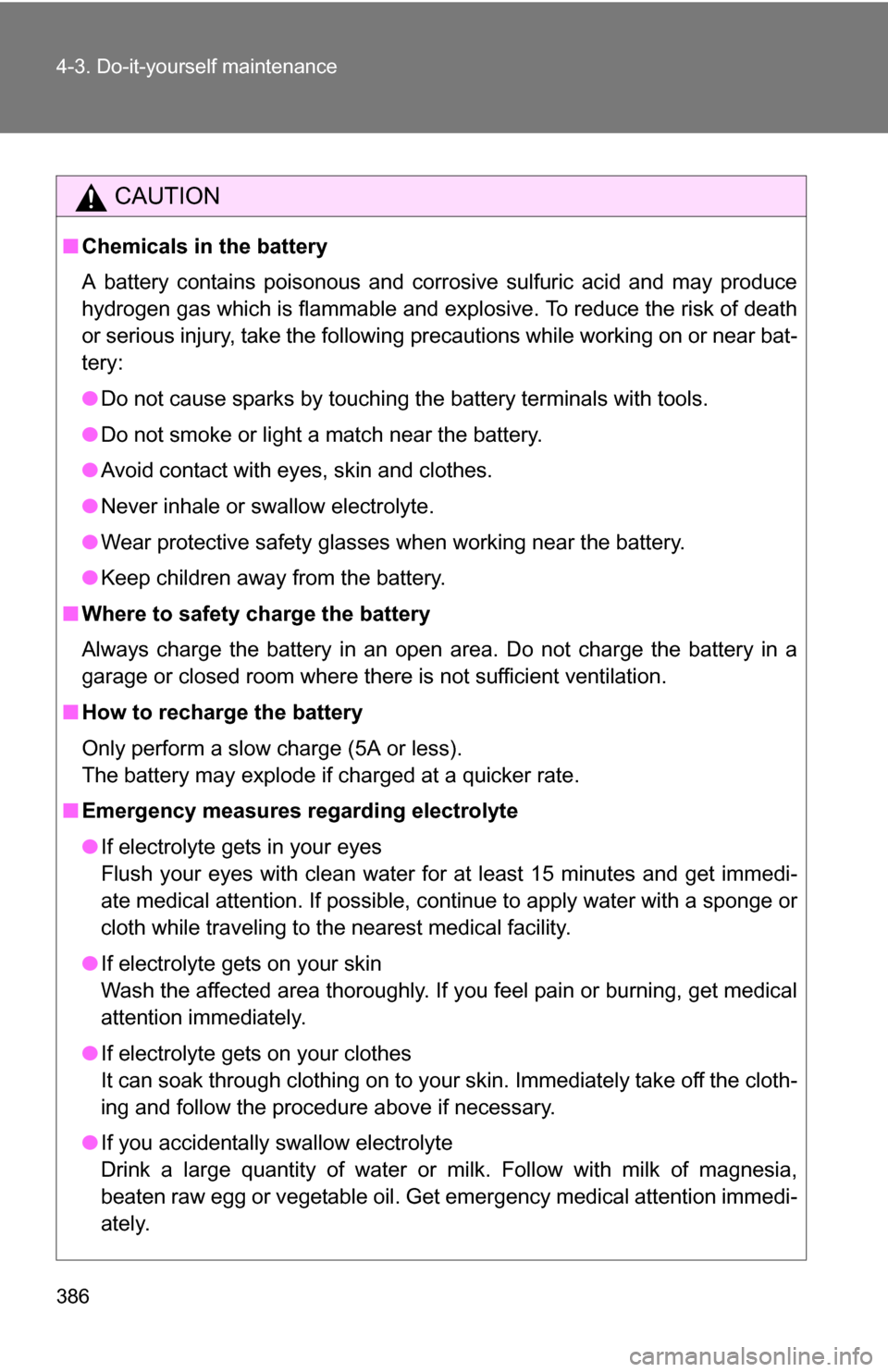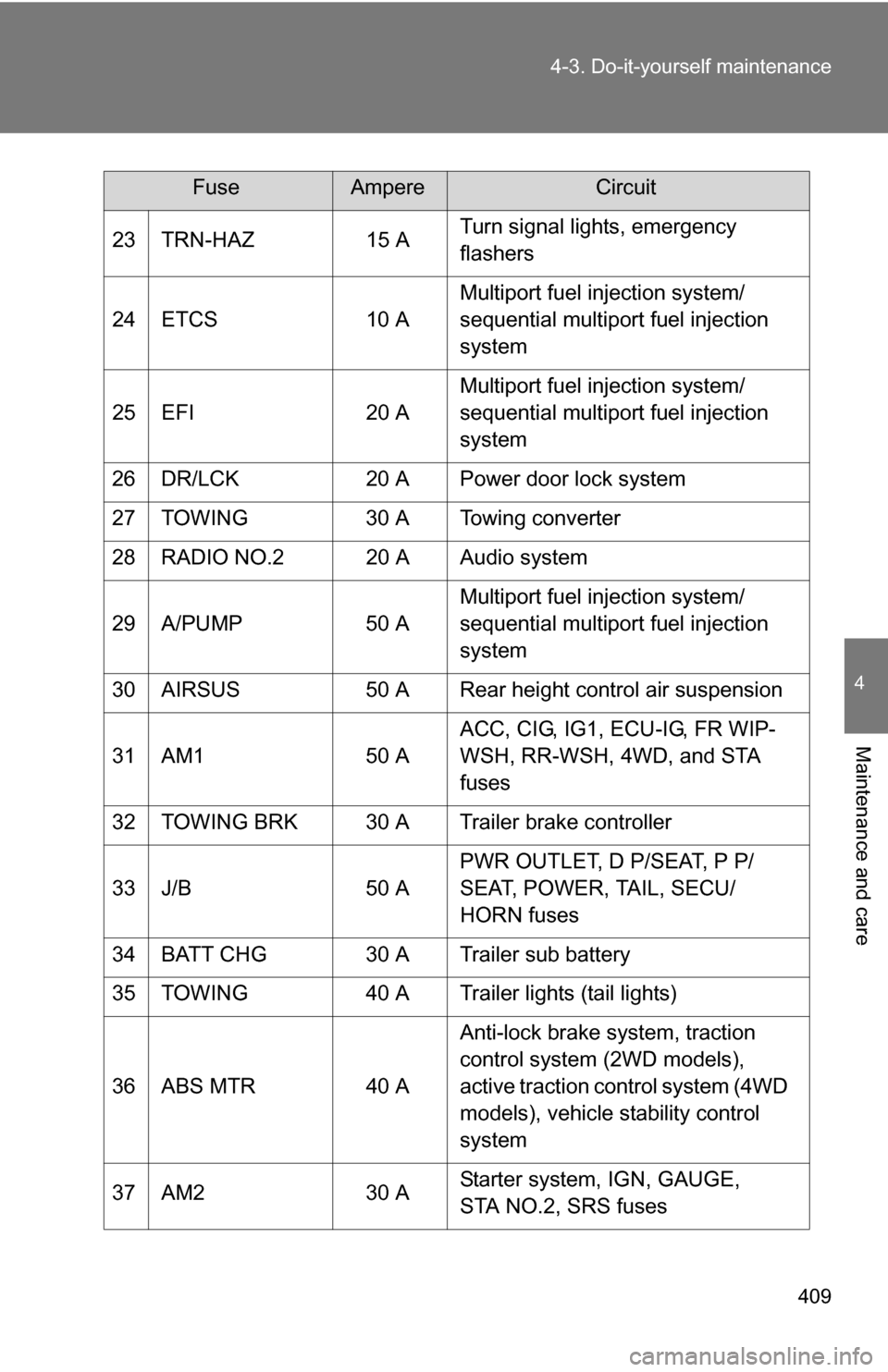Page 383 of 520
383
4-3. Do-it-yourself maintenance
4
Maintenance and care
Power steering fluid
■ Fluid level
The fluid level should be within the appropriate range.
Full (when cold)
Add fluid (when cold)
Full (when hot)
Add fluid (when hot)
Hot: Vehicle has been driven around 50 mph (80 km/h) for 20 minutes, or slightly longer in frigid temperatures. (Fluid
temperature, 140°F - 175°F [60°C - 80°C])
Cold: Engine has not been run for about 5 hours. (Room tem- perature, 50°F - 85°F[10°C - 30°C])
■ Checking the fluid level
Make sure to check the fluid type and prepare the necessary items.
Clean all dirt off the reservoir.
Remove the cap by turn ing it counterclockwise.
Wipe the dipstick clean.
Reinstall and remove the reservoir cap again.
Check the fluid level.
Fluid type Automatic transmission fluid DEXRON® II or III
Items Rag or paper towel
Page 385 of 520
385
4-3. Do-it-yourself maintenance
4
Maintenance and care
■
Checking battery condition
Check the battery condition using the indicator color.
Type A
Blue: Good condition
White: Charging is necessary.
Have the vehicle inspected by
your Toyota dealer.
Red: Not working properly,
have the battery checked by
your Toyota dealer.
Type B Green: Good condition
Dark: Charging is necessary.
Have the vehicle inspected by
your Toyota dealer.
Clear or light yellow: Not work-
ing properly, have the battery
checked by your Toyota
dealer.
■Before recharging
When recharging, the battery produces hydrogen gas which is flammable
and explosive. Therefore, before recharging:
●If recharging with the battery installed on the vehicle, be sure to discon-
nect the ground cable.
● Make sure the power switch on the charger is off when connecting and
disconnecting the charger cables to the battery.
Page 386 of 520

386 4-3. Do-it-yourself maintenance
CAUTION
■Chemicals in the battery
A battery contains poisonous and corrosive sulfuric acid and may produce
hydrogen gas which is flammable and explosive. To reduce the risk of death
or serious injury, take the following precautions while working on or near bat-
tery:
● Do not cause sparks by touching the battery terminals with tools.
● Do not smoke or light a match near the battery.
● Avoid contact with eyes, skin and clothes.
● Never inhale or swallow electrolyte.
● Wear protective safety glasses when working near the battery.
● Keep children away from the battery.
■ Where to safety charge the battery
Always charge the battery in an open area. Do not charge the battery in a
garage or closed room where there is not sufficient ventilation.
■ How to recharge the battery
Only perform a slow charge (5A or less).
The battery may explode if charged at a quicker rate.
■ Emergency measures regarding electrolyte
●If electrolyte gets in your eyes
Flush your eyes with clean water for at least 15 minutes and get immedi-
ate medical attention. If possible, continue to apply water with a sponge or
cloth while traveling to the nearest medical facility.
● If electrolyte gets on your skin
Wash the affected area thoroughly. If you feel pain or burning, get medical
attention immediately.
● If electrolyte gets on your clothes
It can soak through clothing on to your skin. Immediately take off the cloth-
ing and follow the procedure above if necessary.
● If you accidentally swallow electrolyte
Drink a large quantity of water or milk. Follow with milk of magnesia,
beaten raw egg or vegetable oil. Get emergency medical attention immedi-
ately.
Page 387 of 520
387
4-3. Do-it-yourself maintenance
4
Maintenance and care
Washer fluid
Add washer fluid in the following situations.
● Any washer does not work.
● The low washer fluid warning light comes on. (Canada only)
Open the lid.
Check the washer fluid level on
the level gauge.NORMAL
LOW
NOTICE
■When recharging the battery
Never recharge the battery while the engine is running. Also, be sure all
accessories are turned off.
Page 390 of 520

390 4-3. Do-it-yourself maintenance
Installing tire pressure warning valves and transmittersWhen replacing tires or wheels, tire pressure warning valves and
transmitters must also be installed.
When new tire pressure warning valves and transmitters are installed,
new tire pressure warning valve and transmitter ID codes must be regis-
tered in the tire pressure warning computer and tire pressure warning
system must be initialized. Have tire pressure warning valve and trans-
mitter ID codes registered by your Toyota dealer. (P. 390)
Registering ID codes
The tire pressure warning valve and transmitter is equipped with a
unique ID code. When replacing a tire pressure warning valve and
transmitter, it is necessary to regi ster the ID code of tire pressure
warning valve and transmitter. Have the ID code registered by your
Toyota dealer.
■When to replace your vehicle's tires
Tires should be replaced if:
●You have tire damage such as cuts, splits, cracks deep enough to
expose the fabric or bulges indicating internal damage
●A tire goes flat repeatedly or c annot be properly repaired due to the
size or location of a cut or other damage
If you are not sure, consult with your Toyota dealer.
■Replacing tires and wheels
If the ID code of the tire pressure warning valve and transmitter is not
registered, the tire pre ssure warning system will not work properly. After
driving for about 20 minutes, the ti re pressure warning light comes on
after blinking for 1 minute to indicate a system malfunction.
■Tire life
Any tire over 6 years old must be checked by a qualified technician even
if they have seldom or never been used or damage is not obvious.
Page 407 of 520
407
4-3. Do-it-yourself maintenance
4
Maintenance and care
Fuse layout and amperage ratings
■ Engine compartment
FuseAmpereCircuit
1 SPARE 10 A Spare fuse
2 SPARE 15 A Spare fuse
3 STOP 10 A Stop/tail lights, high mounted stop-
light, shift lock control system, anti-
lock brake system, traction control
system (2WD models), active trac-
tion control system (4WD models),
vehicle stability control system,
rear height control air suspension,
multiport fuel injection system/
sequential multiport fuel injection
system, trailer brake controller,
trailer lights (tail lights)
4 AC 115V INV 15 A AC inverter
5 FR FOG 15 A Front fog lights
6 OBD 7.5 A On-board diagnosis system
7 HEAD (LO RH) 10 A Right-hand headlight (low beam)
8 HEAD (LO LH) 10 A Left-hand headlight (low beam)
Page 408 of 520

408 4-3. Do-it-yourself maintenance
9 HEAD (HI RH) 10 A Right-hand headlight (high beam)
10 HEAD (HI LH) 10 A Left-hand headlight (high beam)
11 EFI NO.2 10 A Multiport fuel injection system/
sequential multiport fuel injection
system
12 HEATER NO.2 7.5 A Air conditioning system
13 AIRSUS NO.2 10 A Rear height control air suspension
14 SEAT HEATER 25 A Seat heaters
15 DEFOG 30 A Back window defogger, multiport
fuel injection system/sequential
multiport fuel infection system
16 MIR HEATER 10 A Outside rear view mirror heater
17 DOME 10 A Interior light, personal lights, wire-
less remote control system, door
courtesy lights, gauge and meter,
vanity lights, instrument panel
lights, running board lights, multi-
plex communication system
18 RADIO NO.1 20 A Audio system, navigation system,
rear seat entertainment system
19 ECU-B 10 A Anti-lock brake system, traction
control system (2WD models),
active traction control system (4WD
models), vehicle stability control
system, air conditioning system,
multiplex communication system,
theft deterrent system, driving posi-
tion memory system, front passen-
ger occupant classification system
20 ALT-S 7.5 A Charging system
21 HORN 10 A Horns
22 A/F HEATER 15 A A/F sensor
FuseAmpereCircuit
Page 409 of 520

409
4-3. Do-it-yourself maintenance
4
Maintenance and care
23 TRN-HAZ
15 ATurn signal lights, emergency
flashers
24 ETCS 10 AMultiport fuel injection system/
sequential multiport fuel injection
system
25 EFI 20 AMultiport fuel injection system/
sequential multiport fuel injection
system
26 DR/LCK 20 A Power door lock system
27 TOWING 30 A Towing converter
28 RADIO NO.2 20 A Audio system
29 A/PUMP 50 AMultiport fuel injection system/
sequential multiport fuel injection
system
30 AIRSUS 50 A Rear height control air suspension
31 AM1 50 AACC, CIG, IG1, ECU-IG, FR WIP-
WSH, RR-WSH, 4WD, and STA
fuses
32 TOWING BRK 30 A Trailer brake controller
33 J/B 50 APWR OUTLET, D P/SEAT, P P/
SEAT, POWER, TAIL, SECU/
HORN fuses
34 BATT CHG 30 A Trailer sub battery
35 TOWING 40 A Trailer lights (tail lights)
36 ABS MTR 40 AAnti-lock brake system, traction
control system (2WD models),
active traction control system (4WD
models), vehicle stability control
system
37 AM2 30 AStarter system, IGN, GAUGE,
STA NO.2, SRS fuses
FuseAmpereCircuit